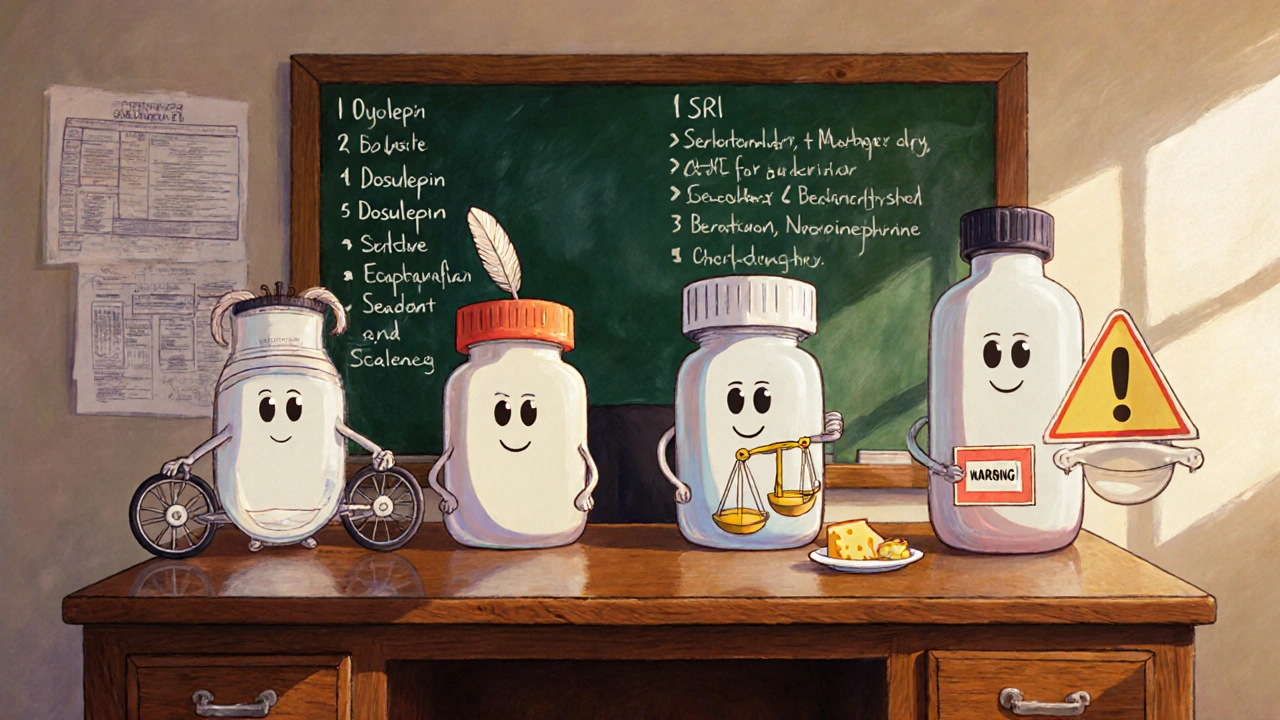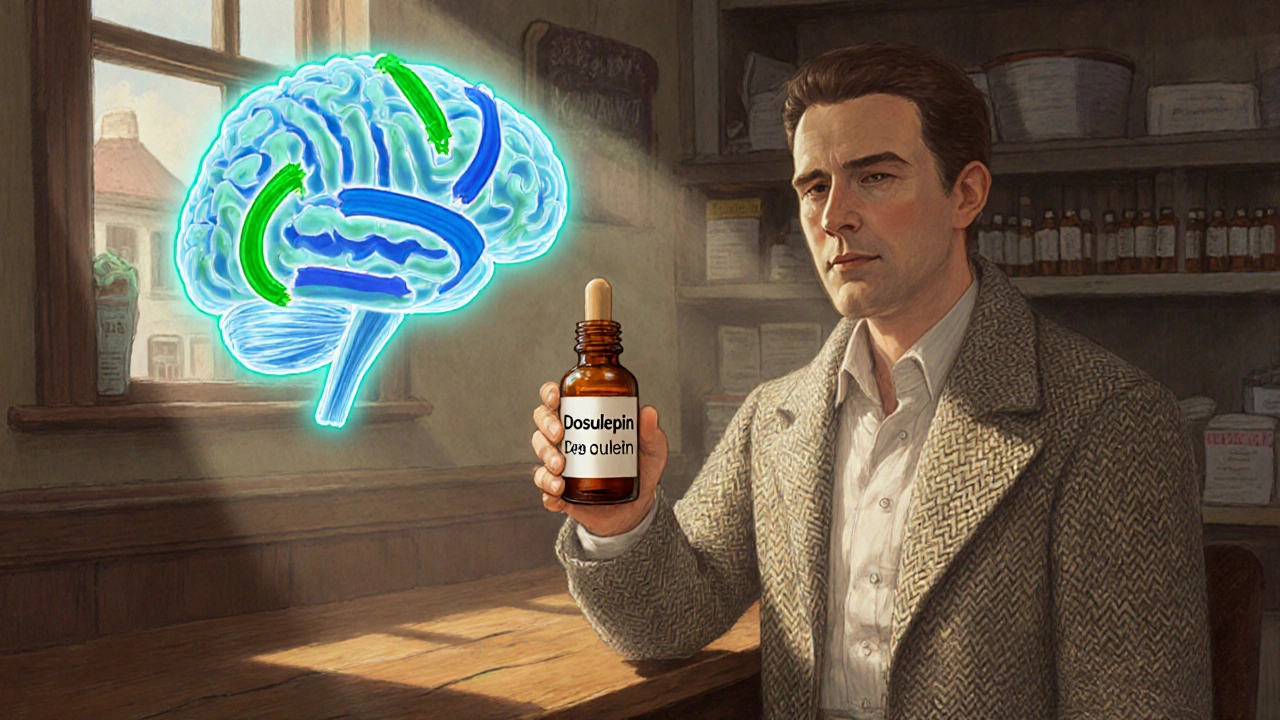When you or a loved one need a mood‑lifting pill, the sheer number of options can feel overwhelming. Dosulepin is a tricyclic antidepressant (TCA) that’s been on the market for decades, yet many people still wonder how it truly stacks up against newer drugs like SSRIs or SNRIs. This guide walks you through the core benefits and side‑effect profiles of dosulepin and its most common peers, so you can see which fit might match your lifestyle and health goals.
What is Dosulepin and How Does It Work?
Dosulepin (also sold as Dothiepin) belongs to the tricyclic family. It increases the levels of serotonin and norepinephrine in the brain by blocking their re‑uptake, which helps lift mood and reduce anxiety. Because it touches two neurotransmitters, it often feels more “potent” for severe depression, but that same potency can bring a broader side‑effect spectrum.
How Do Other Antidepressant Classes Differ?
Selective Serotonin Reuptake Inhibitors (SSRIs) such as fluoxetine or sertraline work mainly on serotonin, offering a cleaner side‑effect profile for many users. Serotonin‑Norepinephrine Reuptake Inhibitors (SNRIs) like venlafaxine hit both serotonin and norepinephrine, similar to TCAs but with fewer anticholinergic effects. Monoamine Oxidase Inhibitors (MAOIs) prevent the breakdown of monoamines and are usually reserved for treatment‑resistant cases because of strict dietary restrictions.
Key Benefits of Dosulepin
- Strong efficacy for melancholic and severe depression.
- Helpful for patients with chronic pain, as norepinephrine boost can reduce pain perception.
- Often effective when SSRIs have failed, due to its dual neurotransmitter action.
Because it’s been around since the 1960s, clinicians have a deep understanding of dosing strategies and drug‑interaction patterns.
Benefits of Common Alternatives
- SSRIs (e.g., fluoxetine, sertraline) - lower risk of weight gain, sedation, and cardiac issues.
- SNRIs (e.g., venlafaxine, duloxetine) - useful for both depression and neuropathic pain, with a more predictable side‑effect profile.
- MAOIs (e.g., phenelzine) - can be lifesavers for atypical depression when other meds don’t work.

Side‑Effect Profile of Dosulepin
TCAs carry a classic set of anticholinergic side effects:
- Dry mouth, blurred vision, constipation.
- Potential for orthostatic hypotension (dizziness when standing).
- Weight gain and increased appetite.
- Cardiac conduction delays (especially in higher doses or older patients).
Because dosulepin is metabolized by the liver enzyme CYP2D6, people who are “poor metabolizers” may experience higher blood levels and more intense side effects.
Side‑Effects of Other Antidepressants
- SSRIs - nausea, insomnia, sexual dysfunction, occasional increased anxiety in the first weeks.
- SNRIs - similar to SSRIs but can raise blood pressure at high doses.
- MAOIs - risk of hypertensive crisis if combined with tyramine‑rich foods (cheese, wine).
Overall, the newer classes tend to have fewer life‑threatening effects but still carry the nuisance side effects that can affect adherence.
Practical Comparison Table
| Drug/Class | Typical Dose Range | Primary Benefits | Common Side Effects | Special Considerations |
|---|---|---|---|---|
| Dosulepin (TCA) | 25‑300 mg/day | Strong effect on severe depression; helps chronic pain | Dry mouth, constipation, dizziness, weight gain, cardiac QT prolongation | Monitor ECG in >150 mg/day; avoid in CYP2D6 poor metabolizers |
| SSRIs (e.g., fluoxetine) | 20‑80 mg/day | Effective for mild‑moderate depression; low fatal overdose risk | Nausea, insomnia, sexual dysfunction, transient anxiety | Watch for serotonin syndrome if combined with other serotonergic drugs |
| SNRIs (e.g., venlafaxine) | 75‑375 mg/day | Depression + neuropathic pain; broader neurotransmitter coverage | Blood pressure rise, nausea, sexual dysfunction | Check blood pressure after dose escalation |
| MAOIs (e.g., phenelzine) | 15‑90 mg/day | Atypical depression, panic disorder | Hypertensive crisis with tyramine, weight gain, drowsiness | Strict diet; wash‑out period before switching to other antidepressants |
Choosing the Right Medication for You
There’s no one‑size‑fits‑all answer, but a few decision points help narrow the field:
- Severity of symptoms: If depression is severe or accompanied by chronic pain, dosulepin’s dual action might be worth the extra monitoring.
- Medical history: Cardiac issues, glaucoma, or a history of falls tip the scale toward SSRIs or SNRIs.
- Drug interactions: Check any current meds that affect CYP2D6 (e.g., fluoxetine, quinidine) before starting dosulepin.
- Side‑effect tolerance: If anticholinergic effects (dry mouth, constipation) are a deal‑breaker, newer agents are preferable.
- Lifestyle considerations: MAOIs demand dietary vigilance, making them less convenient for many.
Discuss these points with a prescriber; they can run a simple ECG, review your medication list, and suggest the lowest effective dose.
When to Seek Professional Advice
Regardless of the drug you’re on, call your doctor or mental‑health provider if you notice:
- Persistent suicidal thoughts or a sudden mood shift.
- Severe dizziness, fainting, or heart palpitations (possible TCA cardiac effect).
- Unexplained weight gain or severe constipation lasting more than a week.
- Signs of serotonin syndrome (agitation, rapid heartbeat, fever, muscle rigidity).
Early intervention can prevent complications and keep treatment on track.
Frequently Asked Questions
Is dosulepin still prescribed in Australia?
Yes, dosulepin is listed on the Australian PBS and can be prescribed for major depressive disorder when other options are unsuitable or have failed.
How long does it take for dosulepin to start working?
Therapeutic effects usually appear after 2‑4 weeks of consistent dosing, though some patients report mood improvement within the first week.
Can I switch from an SSRI to dosulepin safely?
A wash‑out period of at least 5‑7 days is recommended to avoid serotonin syndrome, especially if the SSRI has a long half‑life (e.g., fluoxetine).
What should I do if I miss a dose of dosulepin?
Take the missed tablet as soon as you remember, unless it’s almost time for the next dose. Never double‑dose to catch up.
Are there any foods or drinks I must avoid while on dosulepin?
Unlike MAOIs, dosulepin has no strict dietary restrictions, but alcohol can increase sedation and should be limited.
Finding the right antidepressant is a personal journey that balances effectiveness, side‑effects, and lifestyle. By comparing dosulepin’s strengths and drawbacks against newer classes, you’re better equipped to have an informed conversation with your healthcare provider-one that leads to a treatment plan you can stick with.


Greg Galivan
October 25, 2025 AT 15:58If you’re still guessing whether a TCA like dosulepin belongs in a modern pharmacy, you’re missing the point that efficacy doesn’t disappear just because a drug is old. Its dual serotonin‑norepinephrine action can outshine many SSRIs when the depression is severe or accompanied by chronic pain. Sure, the side‑effect list looks scary, but most do’s are manageable with proper dosing and monitoring. Don’t let the hype around newer meds blind you to a medication that’s proven for decades. The real issue is often how clinicians tailor the dose and watch for cardiac effects, not the molecule itself.
Anurag Ranjan
October 25, 2025 AT 19:56Everyone should check their CYP2D6 status before starting dosulepin it can prevent unexpected side effects and help choose the right dose quickly
James Doyle
October 25, 2025 AT 23:16From a pharmacological perspective the distinction between tricyclics and newer agents often gets lost in lay discussions, yet the mechanistic nuance is critical for clinical outcomes. Dosulepin’s inhibition of both serotonin and norepinephrine reuptake offers a broader neurotransmitter modulation compared to the relatively selective SSRIs, which can translate into superior efficacy in melancholic depression phenotypes. Moreover, the analgesic adjunct properties observed in chronic neuropathic pain cohorts provide an ancillary therapeutic benefit not commonly seen with first‑line serotonergic agents. Nevertheless, the anticholinergic burden-dry mouth, blurred vision, constipation-remains a non‑trivial consideration, especially for geriatric populations with polypharmacy. Cardiac conduction delays, particularly QT prolongation, necessitate baseline ECG screening in patients exceeding 150 mg daily or those with preexisting arrhythmias. The pharmacokinetic profile, heavily reliant on CYP2D6 metabolism, introduces genotype‑driven variability; poor metabolizers may experience supratherapeutic plasma concentrations, amplifying both efficacy and adverse effect risk. In contrast, SSRIs such as sertraline present a lower fatal overdose risk due to their higher therapeutic index, albeit at the cost of sexual dysfunction and initial activation anxiety in some users. SNRIs occupy a middle ground; venlafaxine, for instance, shares the dual reuptake inhibition but mitigates anticholinergic sequelae while still imposing a potential hypertensive response at higher dosages. MAOIs, while effective for atypical presentations, suffer from dietary restrictions that limit adherence in modern lifestyles. Ultimately, the decision matrix should incorporate severity of depressive symptoms, comorbid pain syndromes, cardiac health, and genetic testing where feasible, aligning therapeutic potency with safety profiles. This comprehensive appraisal underscores why dosulepin remains a viable option despite the proliferation of newer antidepressants.
Edward Brown
October 26, 2025 AT 02:53It’s not a coincidence that pharma pushes the newest pills while older ones like dosulepin get a bad rap – they want us to think newer equals safer, ignoring the hidden data on long‑term outcomes; the real control lies in the side‑effect narratives they feed us.
ALBERT HENDERSHOT JR.
October 26, 2025 AT 06:03Let's keep the conversation constructive – the table you shared makes it clear that each class has trade‑offs, and a shared decision‑making approach helps patients feel empowered. 😊 Monitoring ECGs for higher dosulepin doses and checking blood pressure with SNRIs are practical steps we can all recommend.
Suzanne Carawan
October 26, 2025 AT 10:13Nice breakdown.
Kala Rani
October 26, 2025 AT 14:23Sure why not pick the oldest drug just because it’s cheap ignore the side effects
Donal Hinely
October 26, 2025 AT 18:33When you compare dosulepin to SSRIs you’re basically weighing a heavyweight boxer against a sprinter – both can win fights but you need the right arena and a good coach.